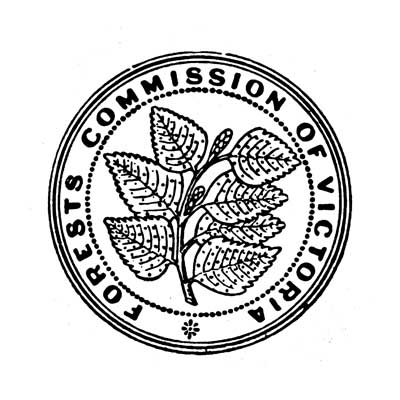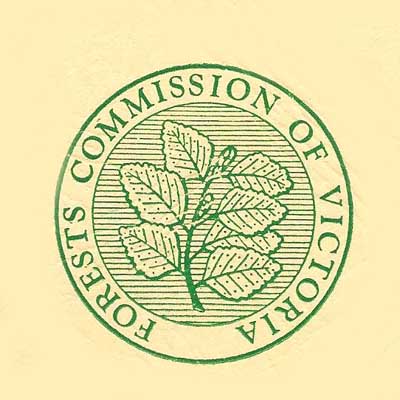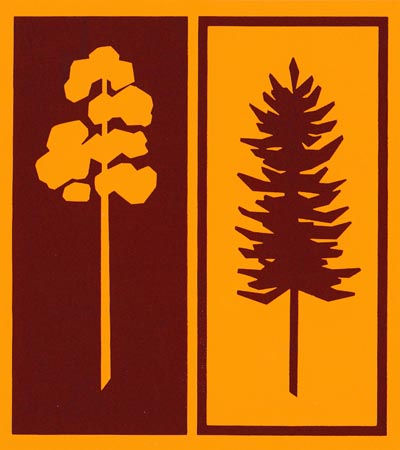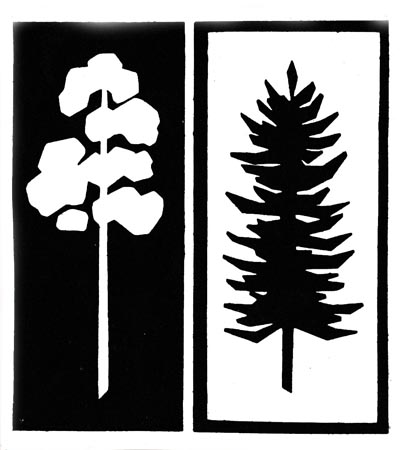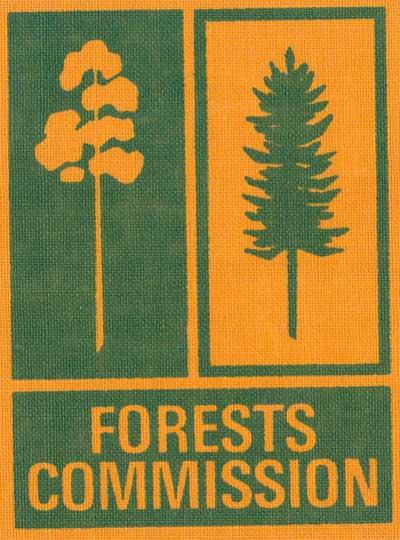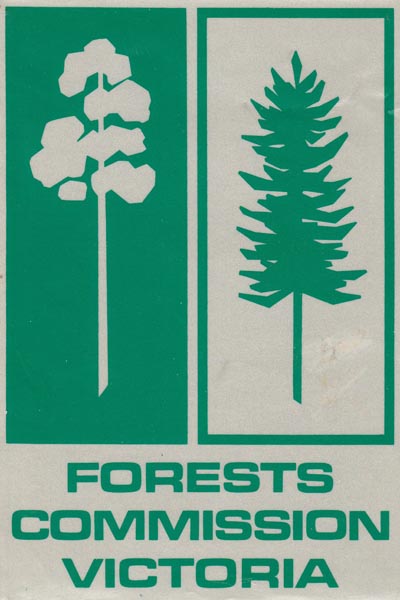Introduction
The first seven decades of forestry in the new State of Victoria was a tug of war between extensive clearing for mining, a government need to establish a thriving farming sector, and wasteful illegal logging pulling in one direction and the need for protection and sound management of native forests pulling in the opposite direction.
The FCV was borne out of these circumstances. The establishment of the FCV in 1918 set up Victoria’s first adequately-staffed and reliably-funded forest service, with a comprehensive charter underpinned by legislation and government policies to soundly protect and manage forests.
This article covers the period from 1850’s until the milestone event of the establishment of the FCV in 1918.
Gold Rush and Victoria’s Proclamation Coincide
The 1851 discovery of gold in the same year that Victoria was proclaimed was an auspicious start for the new State.
Substantial changes followed the discovery of gold in the Ballarat area in 1851, followed shortly after with discoveries at Bendigo, Heathcote, Wedderburn and Beechworth. The State quickly became a gold-based economy. The changes included:
- A population explosion on the gold fields - the State’s population of 100,000 in 1851 increased five-fold over the following six years
- The diggers cleared forests over widespread areas for surface mining
- There was a huge increase in demand for timber for firewood for steam engines used in mining, lining the shafts of underground mines, firewood for heating in Melbourne and towns, and timber for buildings, bridges and railway lines
- The desire and need to expand farming to provide food for the exploding population, and as an opportunity for the investment of the new mining wealth
- Rapid generation of wealth for miners flowing to others as the new wealth was spent
Agents of Forest Clearing and Degradation
The main agents of loss and degradation of forests were mining, farming, wasteful timber milling and fires. Large areas of forests were cleared and others degraded directly by mining, the alienation of Crown land for farming, and wasteful logging to meet the increasing demand for timber. Fires also destroyed forests including the particularly devastating fires on “Black Thursday” in 1851, and “Red Tuesday” in 1898.
Forest Conservation Campaign Emerges
The visual impact of the extensive loss and degradation of the forests was readily apparent, and quickly raised the concern of individuals and various organised groups with different interests. However, the concern about the mistreatment of forests was a unifying cause. A forest conservation campaign grew out of these circumstances, and brought together some unlikely ‘bed fellows’ over time.
Forest Issues and Mounting the Campaign – There’s Nothing New Under the Sun
Management of native forests became contentious almost from the day of Victoria’s proclamation. The arguments, counter-arguments, public campaigning, lobbying of politicians and shifting positions of activists continues even now. In fact, the fight for the forests was not a discrete campaign that had a start and finish date. The struggle has been ongoing for as long as activists have had unfilled aspirations about Victoria’s public forests. Given that expectations and aspirations are a continuum in time, the contentious struggles are likely to continue well into the future. Whilst the intensity of the fight has ebbed and flowed with changing circumstances, it has never ceased nor reached an end goal.
It’s interesting to reflect on the issues, arguments and processes used to achieve government change. The early day approaches have changed little over more than a century and a half. Similar issues, pro and con arguments and agitation techniques are used today, as were used when the campaign started in the 1860’s. This is illustrated by examples as follows:
- Melbourne Water Supply Catchment Management. The debate about whether Melbourne’s water supply catchment should be closed was first raised in 1897. The Government engaged an external forestry expert, the Indian Forest Service Inspector-General Ribbentrop to review and recommend on Victoria’s forests. He recommended that the 56,000 ha Melbourne water supply catchment should be actively managed and harvested.
- National Park for Central Highlands. In the 1920’s the Field Naturalists Club Victoria (FNCV) argued for the declaration of a National Park centred on the Cumberland Valley.
- Sustainable Management of Forests. The forests were wastefully logged to supply the exponentially increasing demand for timber from the 1860’s. The forests close to Melbourne and in close proximity to towns were being heavily overcut. George Perrin, Conservator of Forests, recommended in 1888 that the total annual cut should be no greater than the annual forest growth. This policy was included in the Government’s Timber Industry Strategy a century later in 1986.
- How to Influence Governments. Public forests were under government control and hence the need to influence government decisions. The campaign over a number of decades was based on techniques still used today, including raising awareness to get public support, open and covert lobbying of parliamentarians, persistence, and consolidate stepwise advances and quickly move on to the next goal.
Governments were cautious and slow to act to improve the conservation of forests. There were good arguments in favour of clearing forests for farming and other reasons, as there were good arguments for protecting and conserving forests. The balance to be struck was always going to be controversial as there were strong and influential interests on both sides. As is often the case is such situations, governments had difficulty moving quickly or decisively. It took six decades to establish comprehensive forest conservation legislation and set up an adequately-resourced and professional forest department in the form of FCV. This is an example of governments reactively following public support and effective agitation for sound forest policy.
The First Forest Conservation Campaign
1. Opposing Pressures
- Alienation of Crown land for farming. Releasing land for farming was encouraged by parliamentarians and championed by the Minister for Lands and Agriculture. There was a need to increase food production for the rapidly expanding population, and investing the new wealth of miners who aspired to be successful farmers was regarded positively. Many saw clearing as a sign of progress, and settlers clearing forests for farms were regarded as ‘heroic nation builders’.
The rate of clearing was substantial. In 1855 the area under crop farming in Victoria was 40,000 ha. This increased by 30,000 ha each year for the following 59 years to reach the total of 1.8 million ha by 1914. Much of the increase was on cleared forest.
How then to balance the competing interests of more land for farming with reserving areas as permanent forests? - Uncontrolled wasteful logging. The early Forests Branches were meant to control timber harvesting on Crown land through a licencing system. However, the system was grossly inadequate. The Minister for Lands and Agriculture in his report to Parliament described the licence system as …….“no more effectual method of legalising the destruction of timber could have been devised”.
In 1888 Forest Conservator George Perrin reported that 200,000 ha of forests in the Central Divide from Woodend to Creswick had been stripped by wasteful logging and were in a degraded state. This activity, whilst indefensible, still had the significant impact of forest degradation. - Destruction by fire.The areas devastated by fire were larger than should have been the case as a result of ineffective fire protection.
- Organised Mining Interests are the Early Agitators – Oh the Irony! Clearing forests to access areas to prospect, and for mining timber and firewood were significant early causes of widespread forest clearing. It is surprising and ironic that organised mining interests, including influential mining parliamentarians, were the early public advocates for forest protection, taking up the cause in the 1860’s. Their advocacy was based more on the profitability of their mining interests than forest ecology. The miners wanted well-regulated state forest reserves to ensure a plentiful future supply of mining timbers at reasonable prices.
2. The Campaign Expands
As the need for action became more apparent, a diverse range of individuals and organisations came on board. Some of the individuals coalesced and organisations were formed to join the cause. The main parties were:
- 1865 - The Argus newspaper took up the cause of ‘protecting our forests’ arguing the substantial benefits of timber production, avoiding the wasting of soil, conserving natural streams, avoiding adverse climate impacts and beneficially distributing storm runoff.
- 1871 - the Australian Natives Association (ANA) was formed and joined the campaign. ANA was active on forest conservation for a prolonged period.
Newspapers in mining areas in Ballarat, Bendigo and Maryborough promoted the case through their newspapers.
The Amalgamated Miners’ Association (AMA) became active as increasing timber prices threatened mining jobs.
- 1881 - the Field Naturalist Club Victoria (FNCV) became actively involved. FNCV advocated a new National Park centred on the Cumberland Valley in the 1920’s. Timber millers, local mining communities and apiarists supported the campaign. The supporting timber millers had either changed their ways from earlier times, or were not previously involved in wasteful and/or illegal logging.
- 1888 - the Northern District Conservation League (NDCL) supported the campaign but was short-lived being dissatisfied with lack of progress.
- 1903 - the National Forest Protection League (NFPL) was a supporter and prosecuted the argument about the hydrological importance of forests to support irrigation for farming.
- 1907 - professional foresters and academics joined the campaign as organised mining interests faded because of the demise of mining.
- 1909 - timber manufacturers actively argued for local timber from dedicated forests to replace imports. They also recommended the government establish seasoning works and a sawmill to ensure reliable supply of seasoned of ash timbers.
- 1912 - the Australian Forests League (AFL) was formed as a national organisation with the Victorian branch being the most active. AFL joined the cause led by its first President, Albert Ewart, head of Melbourne University’s Botany Department, and second President, Russell Grimwade, a forester working with the Forests Department at the time.
The above illustrates great diversity in the interests of the supporters of the campaign to protect and conserve forests. It may be that the meaning of ‘protect and conserve’ was not precisely defined at the time, so parties could join harmoniously in the general common cause. Subsequently some of the environmentally-focussed groups differed with others on whether and how harvesting should occur in some forests.
3. Successes of the Campaign
Slow progress occurred in a stepwise manner until comprehensive forest legislation was enacted, and an independent professional and well-resourced forest department was established in 1918. The efforts of those supporting the campaign were obviously influential. However, government decisions do require a confluence of circumstances including the merits of the policy, public support, effective lobbying of members of parliament, government willingness, financial capacity and political advantage at the time. A number of these came together in 1918.
- Areas permanently reserved as forests. Permanent forest areas were reserved under the Lands Acts prior to the 1918 Forest Act, which was a limitation as the Minister of Lands and Agriculture was also responsible for alienating Crown land for farming and towns. As such the Minister was inherently conflicted in administering competing responsibilities. As a result permanent forest reservation was slow and limited for the period of Victoria’s first seven decades.
Reservations were made in 1862, 1873, 1898 and 1903. Conservator of Forests George Perrin reported the total forested area in 1888 was 4.8 million ha most of which was inaccessible. Only a small proportion was permanently reserved, and some was in water supply catchments closed to harvesting and visitors. - Inquiries and Commissions. Governments over the period established a number of inquiries and Commissions at various times when pressed to improve forest conservation. The more significant of these were the Ribbentrop review which commenced in 1895, and the Royal Commission from 1898-1901.
Ribbentrop’s review was comprehensive and found the forests in a poor state. He reported ….’State forest conservancy and management are in an extraordinarily backward state’. Even though the government of the day did not immediately embrace his recommendations, the report was the catalyst for the Royal Commission which commenced in 1898.
The three year Royal Commission was extensive and thorough, and made detailed recommendations on fundamental requirements for effective management of forests, including legislation, policy, funding and adequate well-trained staff. The recommendations were not immediately taken up, but were embraced progressively in the 1904 reorganisation of the Department, movement of the Department to the Mines Ministry from 1905, the establishment of the 1907 Forests Act and, finally, the expanded 1918 Forests Act and establishment of the FCV. - Forests Legislation. Progress on legislation was problematic reflecting the challenges balancing the desire to open up more land and the need to protect and conserve forests.
Forests Act 1907. After various commitments, bills were introduced into Parliament in 1879, 1881, 1887 and 1892 but none were enacted. Finally, the first legislation was enacted with the Forests Act 1907. The Act was administered by the Mines Minister, and incorporated some of the Royal Commission’s recommendations. It established a separate Forests Department to apply forest science to managing forests. It also provided for the appointment of a Conservator of Forests, the dedication of permanent reserved forests, more nurseries and an increase the area of softwood plantations, the control of forest products on unoccupied Crown land, and the collection of royalties for forest products.
The Department progressed steadily over the following decade by increasing forest production, improved rehabilitation and silvicultural works in native forests, increased plantations, improved fire protection and established the Victorian School of Forestry to provide professionally trained foresters for the Department.
Forests Act 1918. The 1918 Act and the establishment of the FCV are discussed below.
Organisation of Forest Administration
The Forests Branch was initially located in the Department of Lands and Agriculture under the Lands and Agriculture Minister. The first Conservator of Forests George Perrin was appointed in 1888. He was reportedly a far-sighted and energetic forester and administrator, but filled the post for just two years before he died. The challenge for the Department was being under a Minister with conflicted responsibilities. Releasing Crown land for farming was a higher government priority at the time. Faced with the problem of over-exploited forests, Perrin unsuccessfully recommended a sustained yield policy where the annual harvest was to be no more than the annual forest growth.
The Department was moved to the more supportive Mines Ministry for a brief period in the 1890’s, but then returned to Lands and Agriculture. At this time mining interests were actively agitating for protection and conservation of forests as described above.
The Department was re-organised in 1904 with a promise for a new Forests bill. The new bill was set aside after the government was returned at election on a policy of closer settlement, which maintained pressure to continue to release Crown land.
The Department moved back under the Mines Minister in 1905 where it remained until the new Act in 1918.
- A New Forests Act and the FCV
The above describes the gradual steps towards improving the protection and conservation of the Victoria’s native forests. It seemed progress, though slow, was approaching the goal of comprehensive forest legislation and an effective forest service.
The end of the First World War in 1918 was a telling event. Post-war timber shortages, and the need to employ returned servicemen, highlighted the need for an independent fully professional Forests Department.
The1918 Forests Act was more comprehensive than the earlier Act. It incorporated the principles of conservation, development, utilisation of indigenous forests based on sound forestry principles, establishment of adequate plantations of exotic species, and prosecution of research work covering natural products of the forests.
It provided for reliable funding through a forestry fund which was initially set at £40,000 per year plus 50% of the gross revenue above £80,000 per year, and the ability to recruit required staff.
Priorities were- the protection and systematic management of hardwood forests, and
- the establishment of plantations of exotic softwood species.
The challenge was to address the problem of insufficient permanently reserved forests. Following a 1920 national conference of representatives from Australian states, the FCV adopted the goal of increasing the area of permanently reserved forest to 2.2 million ha, as its share of the national goal of 9.2 million ha.
References
Carron LT (1965-1991). A History of Forestry in Australia. Australian National University Press, published between 1965-1991.
Dingle Tony (1984). The Victorians Settling An Anniversary History University of Melbourne 1984.
Legg Stephen (2016). Political Agitation for Forest Conservation: Victoria, 1860-1960 International Review of Environmental History Volume 2 2016.
Priestley Susan (1984). The Victorians Making their Mark An Anniversary History Melbourne University 1984.
Timber Industry Strategy Victoria 1986 - Victorian Government Statement (1986).

